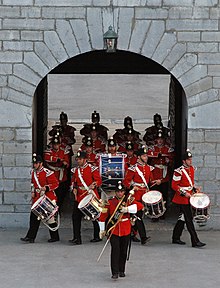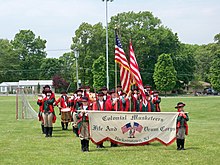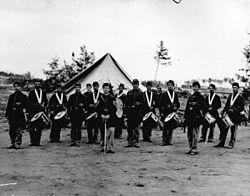Fife and drum corps

A fife and drum corps is a musical ensemble consisting of fifes and drums. In the United States of America, fife and drum corps specializing in colonial period impressions using fifes, rope tension snare drums and rope tension bass drums are known as Ancient Fife and Drum Corps.[1] Many of these ensembles originated from a type of military field music.
History
Fifes are an ancient wind instrument that have evolved over the centuries. The original form was small and bore six finger-holes, but later versions may have various sizes and numbers of holes. While ancient fifes were one-piece and therefor not easily tuned, modern fifes are two pieces connected by a joint made from either metal or cork. Modern 10-hole and 11-hole fifes are chromatic, thus able to play any note as opposed to the more limited ancient fifes, which could only be played in a few keys.
The fife originated in Europe and has spread widely beyond. It is a similar instrument to the German Schweizerpfeife, which translates to "Swiss fife", the Irish flute, baroque flute and the piccolo.[citation needed]
Fifes have been in use by military organizations since the 16th century. Fifes originally accompanied companies of soldiers, providing music while on the march and in camp. Drums have had a role in militaries going back farther in history.[citation needed]
The rise of the modern army began in the late 16th century and evolved throughout the 18th century. Drilling to precise and increasingly complicated geometric movements in close order formation, armies adapted and trained fifers and drummers to signal preparatory alerts and execution signals as well as times of day for the troops. It became customary for each company of 100 or so men to be assigned 2 fifers and 2 drummers to sound signals, hours and alarms, as well as play popular music on the march. This pattern was also practised in the U.S. services from the Revolutionary War up until the late 19th Century. When the companies of a Regiment or Battalion were gathered together, it was customary to assemble the fifes and drums from all the companies into a 'band' to march at the head of the column on parade. When a regimental military band (woodwinds and brass) were also present, the fifes and drums marched at the head, followed by the military band. This is still the custom with British Regimental bands. To this day, the drum major's preparatory command to move a British Army band is, "Band and Drums...". This is referring back to the segregation of the fifes and drums as a separate entity from a military band.

Fifes have always been an infantry musical instrument.[citation needed] Assigned at the company level with 1-2 fifes and 1-2 drums per company (or formed as a band at the regimental level), fifes and drums were used to regulate the daily activities of the troops. They signaled when the troops should rise in the morning and retire at night, when to eat, when to assemble, and to sound an alarm. The infantry used side drums (snare/field, long drum/tenor drum and the bass drum). When detached to the companies, the drummers used only the side drums. Cavalry and Dragoon (mounted infantry) units did not use them, instead utilizing bugles to signal commands. The only remaining Fife and Drum Corps in the American Military is the Fife and Drum Corps of the 3rd U.S. Infantry Regiment (The Old Guard), a ceremonial Army unit based out of Ft. Myer, Virginia, raised in 1960.
The Colonial Williamsburg Fifes and Drums,[2] founded in 1958[3] by the Colonial Williamsburg Foundation,[4] is a professional corps made up of young musicians between the ages of 10 and 18. They are a fine representation of what a fife and drum corps would have looked and sounded like during the mid-eighteenth century when company fifers and drummers came together as a single unit for marches, trooping of the colors, and parades. The Colonial Williamsburg Fifes and Drums depict the Virginia State Garrison Regiment,[5] which served in the Tidewater area of Virginia shortly after the American Revolution.
Modern non-military Fife and Drum Corps are organizations with volunteer or paid performers.[citation needed] Revenue is obtained through fundraising and by performing in town and city parades. Corps performance pieces often reflect the expectations of the audience for these venues (e.g., patriotic and Irish medleys for Memorial Day and St. Patrick's Day, respectively). Sometimes a Fire Department may have their own associated Fife and Drum Corps to march ahead of their fire trucks. Other corps may obtain revenue from reenactment performances. Several times per year various Fife and Drum Corps meet to compete, parade, socialize, and muster at a camp ground or meeting hall (in the winter).

The Marine Corps of the Royal Netherlands Navy employs a Fife and Drum Corps tracing back its roots to 1665 and possibly earlier. In Dutch, the Tamboers en Pijpers are made up of fully trained professional Dutch Marines who play the drums (Tamboer) or fife (Pijper, derived from Pfeife, cognate of Fife). Both categories are fully accomplished as Buglers for Dutch military ceremonial tasks.[6]
Instrumentation
A fife is a woodwind instrument in the transverse flute family, which sounds an octave above the written music and has 6 tone holes (some have 10 or 11 tone holes for added chromatics).[citation needed] Most fifes are wood - blackwood, grenadilla, rosewood, mopane, pink-ivory and other dense woods are superior; maple and persimmon are inferior, but often used, particularly as entry-level instruments. Some corps have used metal fifes. In Civil War corps, bugles are sometimes part of the instrumentation.[citation needed]
Rope-tension snare and bass drums are tightened using tugs or ears that apply pressure to the rope, which is transferred to the heads when the rope compresses the counter hoops, causing them to move slightly closer together.[citation needed] The drum heads used are usually made of lamb or calf skin, or plastic drum heads made by many drum manufacturers. Unlike in the British corps, the single tenor drum is not customarily used in American fife and drum ensembles, although only a few ensembles that play the fife and bugle have them and these were paired in the 1880s in the US Armed Forces with fifes and bugles when these were introduced before the fifes were abandoned.
Performance

The drums are beaten using two sticks. Visual effects may be created by flourishes of the drum sticks; for example, bass drummers may swing the beaters in a flourish while the snare drummers roll (or when the beating leaves sufficient time to flourish).
Songs are chosen based on a number of criteria, and can include both historically significant music and new pieces specifically composed or arranged to be played on fife and drum.
Most fife and drum corps march in parades, perform at concerts, in festivals and state fairs, and expositions.[citation needed] Some fife and drum corps focus on interpreting a specific time period and portray field musicians of the era at living history events and reenactments. Many corps perform together at musters, particularly in the North-East, but also nationally throughout the United States.
The typical[citation needed] uniform of the Ancient Fife and Drum Corps is a representation of some military uniform from the American Revolutionary War. Uniforms often consist of tricorns or cocked hats, waistcoats, knickers (knee breeches) or gaitered trousers, ruffled cuffs, neck stocks, and buckled shoes similar those by the Continental Army or Marines. Only a few wear uniforms of the War of 1812, including shakos. More recently, American Civil War uniforms have risen in prominence, with uniforms and instrumentation based on Civil War units of either the Union or Confederate armies. Headdress worn by these is either the kepi or Forage cap.
Repertoire
- 10th Battalion H.L.I. crossing the Rhine[7]
- Ah, ca ira[8]
- 1812[7]
- All Take Tea[8]
- American Patriot[8]
- America The Beautiful[7]
- An Irish lilt[7]
- Aunt May's Jig[7]
- Barnie O'Neill[7]
- Barren Rocks of Eden[8]
- Battle Hymn of the Republic[8]
- Behind the Bush in the Garden[7]
- Big John McNeil[7]
- Black Watch[8]
- Blackberry blossoms[8]
- Blackberry Quadrille[7]
- Blatchley's Banter[8]
- Blue Bells of Scotland[8]
- Bluff Reel[8]
- Bonaparte Crossing the Rhine[8]
- Bonnie blue flag[8]
- Bonnie Doon[7]
- Boston Tea Party
- Brandywine Quickstep[7]
- Bruce's address[8]
- Caledonia
- Camptown races[8]
- Captain Macintosh[8]
- Chicken reel[7]
- Cincinnati Hornpipe[8]
- Circassian circle[7]
- Clark's hornpipe[8]
- Cock o' the north[7]
- Coleraine[7]
- Columbia, the Gem of the Ocean[7]
- Come under my plaidie[7]
- Comin' thru the rye[7]
- Constitution hornpipe[8]
- Contemporary revolution[8]
- Corn cob clog[8]
- Crown Point[7]
- Daniel of the sun[8]
- Dashing white Sgt.[8]
- Devil of Dublin[8]
- Devil's flute[8]
- Dixie[8]
- Doherty's fancy[8]
- Dohm's express[8]
- Downshire[8]
- Dovecote Park[7]
- Dream quick step[8]
- Drowsy Maggie[7]
- Drums and guns[8]
- Duke of York march[8]
- Duke of York (short troop)[8]
- Dusty Bob's jig[7]
- Dutch fusiliers[8]
- Eddie Clapp 6/8[8]
- Empty pockets[7]
- Essence of Tampa[7]
- Essex march[8]
- Farewell to Whiskey[7]
- Father O'Flynn[7]
- Fiddle hill jig[7]
- Fifer's delight[8]
- Fifer's masterpiece[8]
- Fifty cents[7]
- Finale British laurels[8]
- Finnegan's wake[8]
- Fireman's quick step[8]
- Fireman's reel[8]
- First of September[8]
- Fisher's hornpipe[8]
- Flowers of Edinburgh[7]
- Flowing bowl[8]
- Fort Clinton
- Garry Owen[8]
- Girl I left behind/Brighton Camp[8]
- Glise a Sherbrooke[7]
- Golden slippers[8]
- Gov. king's march[8]
- Grandfather's clock
- Granny, will your dog bite?[8]
- Guilderoy reel[8]
- Guilford polka[7]
- Hail Columbia[7]
- Hail to the Chief[7]
- Hanover[7]
- Hare in the corn[8]
- Harem Scarem[8]
- Haste to the wedding[8]
- Hell on the Wabash[7]
- Holyrood[7]
- Honest John[7]
- House of Duncan[8]
- How are you, Kitty?[8]
- How's your mother?[8]
- Huntsman hornpipe[8]
- Hurrah for the bonnets of blue[7]
- I love nae a laddie but Ane[7]
- I was one Day at whapping[8]
- Irish reel[8]
- Jacob's jig[7]
- Janizary's march[8]
- Jay bird[8]
- Jefferson and liberty[7]
- Julie B.
- Kater Tacawitha[8]
- Katy Hill[8]
- Key West hornpipe[8]
- Kingdom coming[8]
- Kinlin's reel[8]
- Kinlock of Kinlock[7]
- Kitty McGee[7]
- Korn likker[8]
- L'Oiseau royale[7]
- La Bastringue[7]
- Lamplighter's hornpipe[8]
- Larry O'Gaff[8]
- Les fraises et les framboises[7]
- Lilliburlero[8]
- Little brown jug[7]
- Little tea[8]
- Liverpoole[8]
- Love one's fancy[8]
- Maggy Brown's favorite[7]
- Maid on the green[7]
- Major Mackey's jig[7]
- Maple leaf jig[7]
- March on[8]
- Marching thru Georgia[8]
- Mason's apron[8]
- McIntyre[8]
- Merrily danced the Quaker's wife[7]
- Merry men home from the grave[8]
- Minstrel boy[7]
- Miss McLeod's reel[7]
- Molly on the shore[8]
- Morgan's rattler[8]
- Mouse in the cupboard[7]
- My country 'tis of thee[7]
- My mother's eye glowerin owre me[7]
- My wife's a wanton wee thing[7]
- Nelly Bly[8]
- New 6/8[8]
- New tatter jack[7]
- No luck about the house[7]
- No mistake[7]
- Northwest passage[8]
- O Canada[7]
- O lassie art thou sleeping yet[7]
- O'Connor's quick step[8]
- O'Gallagher's hornpipe[8]
- Oak hill reel[8]
- Off she goes[7]
- Oh, Susanna[8]
- Old Dan Tucker[8]
- Old French[7]
- On the road to Galway[7]
- One hundred pipers[8]
- Orcadian jig[7]
- Oswestry volunteers march[8]
- Over the hills and far away[8]
- Oyster river[8]
- Paddy whack[8]
- Pennsylvania quick step[8]
- "Pig Town" fling[7]
- Portland fancy[7]
- Post's quick step[8]
- Power of whiskey[8]
- President Garfield's hornpipe[7]
- Prussia variation[8]
- Pumpkin creek[7]
- Queen of hearts[8]
- Ragtime Annie[7]
- Rakes of Kildare[8]
- Rakes of Mallow
- Rally round the flag[7]
- Red coat fifer[8]
- Red, white, and blue[8]
- Road to Boston[7]
- Rochester Schottishe[8]
- Rondeau[8]
- Rory O'More[8]
- Roxburgh Castle[7]
- Rule, Britannia![8]
- Rustic reel[7]
- Scotland the Brave[7]
- Sgt. O'Leary[8]
- Sherman's march
- Shiley me gile[8]
- Sister's jig[8]
- Slow march 4/4[8]
- Slow troop 3/4[8]
- Smash the windows[7]
- Smith's hornpipe[8]
- Soldier's joy[8]
- Soldier's return[8]
- Some distance from Prussia[8]
- Southern rose polka[8]
- Spanish jigg[7]
- Spider 6/8[8]
- Squirrel hunter's quick step[8]
- St. Lawrence jig[7]
- St. Patrick's day in the morning[7]
- Steamboat quick step[7]
- Steeplechase polka[8]
- Stillman's reel[8]
- Strassburg's quick step[8]
- Strawberry jig[7]
- Successful campaign[8]
- Swallow's Tail[8]
- Swallowtail Jig[7]
- Swanee River[7]
- Swede's Hall[8]
- Swimming in the Gutter[7]
- Tallewan[7]
- Tatterjack[8]
- Teddy O'Neill[8]
- Tenting Tonight[8]
- Teviot Bridge[7]
- The Arkansas traveler[7]
- The Atholl Highlanders[7]
- The Blue and the Grey[7]
- The British Grenadiers[7]
- The Dancing Bear[7]
- The devil's dream[7]
- The Downfall of Paris[7]
- The drunken sailor[7]
- The Dukes Dang o'er his Daddy (buff coat)[7]
- The Duke of Kent's March[8]
- The Dusky Night[7]
- The Green Cockade[7]
- The Gudgeon of Maurice's Car[7]
- The Harriott[7]
- The hundred pipers[7]
- The Irish Washerwoman[7]
- The Kinnegad Slashers[7]
- The Marines' hymn[7]
- The Muffled Drum[8]
- The Old Rocking Chair[7]
- The Oyster girl's Jig[7]
- The Raw Recruit[7]
- The Roving Sailor[7]
- The sailor's hornpipe[7]
- The Scarlet Regiment[8]
- The star-spangled banner[7]
- The Tempest[7]
- The Tenpenny Bit[7]
- The Two and Sixpenny Girl[7]
- The yellow rose of Texas[7]
- The Young Widow[7]
- White Cockade[7]
- The world turned upside down[7]
- Three Hundred Years[8]
- Three Little Drummers[8]
- Tramp tramp tramp[7]
- Turkish March[8]
- Twilight[8]
- Union Quickstep[8]
- Unionvale Fusiliers
- Washington's Artillery March[8]
- Welcome to Cork[7]
- When Johnny comes marching home[8]
- When the cruel war is over[8]
- Willie Weaver[8]
- Wind that shakes the barley[8]
- Yankee Doodle[7]
- Yankee doodle boy
- York Fusiliers[8]
- Yorktown[8]
- Zig-Zag Clog Dance[7]
See also
- Basler drum
- Carnival of Basel
- Corps of drums
- Fife and drum blues
- Fort Henry Guard
- Frederick the Great
- Lancraft Fife and Drum Corps
- Mattatuck Drum Band
- Middlesex County 4H Fife and Drum
- Military drums
- The Rogue's March
Notes
- ^ Clarke, James (2011), Connecticut's Fife & Drum Tradition, Wesleyan University Press, ISBN 978-0-8195-7141-0
- ^ "Fifes & Drums". Colonial Williamsburg. Williamsburg, VA: The Colonial Williamsburg Foundation. Retrieved 9 December 2022.
- ^ Casterline, Jr., William H. (2008). From the Road to Boston To The World Turned Upside Down - 50 Years of the Colonial Williamsburg Fifes and Drums 1958-2008. Fairfax, VA: National Quality Products.
The Colonial Williamsburg Fifes and Drums made its first performance by two fifers and two drummers on July 4, 1958.
- ^ "History of Colonial Williamsburg". Colonial Williamsburg. Retrieved 9 December 2022.
- ^ White, William E. (1990). The Virginia State Garrison Regiment, 1778-1782. John D. Rockefeller Jr. Library.
{{cite book}}: CS1 maint: location missing publisher (link) - ^ Defensie, Ministerie van (2017-11-01). "Tamboers en Pijpers van het Korps Mariniers - Militaire muziek - Defensie.nl". www.defensie.nl (in Dutch). Retrieved 2020-06-11.
- ^ a b c d e f g h i j k l m n o p q r s t u v w x y z aa ab ac ad ae af ag ah ai aj ak al am an ao ap aq ar as at au av aw ax ay az ba bb bc bd be bf bg bh bi bj bk bl bm bn bo bp bq br bs bt bu bv bw bx by bz ca cb cc cd ce cf cg ch ci cj ck cl cm cn co cp cq cr cs ct cu cv cw cx cy cz da db dc dd de df dg dh di dj dk dl dm dn do dp dq dr Sweet, Ralph (1981). The Fifer's Delight. Enfield, CT: Ralph Sweet.
- ^ a b c d e f g h i j k l m n o p q r s t u v w x y z aa ab ac ad ae af ag ah ai aj ak al am an ao ap aq ar as at au av aw ax ay az ba bb bc bd be bf bg bh bi bj bk bl bm bn bo bp bq br bs bt bu bv bw bx by bz ca cb cc cd ce cf cg ch ci cj ck cl cm cn co cp cq cr cs ct cu cv cw cx cy cz da db dc dd de df dg dh di dj dk dl dm dn do dp dq dr ds dt du dv dw dx dy dz ea eb ec ed ee ef eg eh ei ej ek The Company of Fifers and Drummers Music Book. Vol. II. The Company of Fifers & Drummers.

